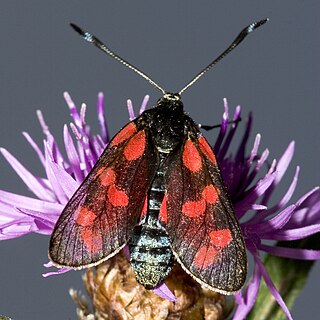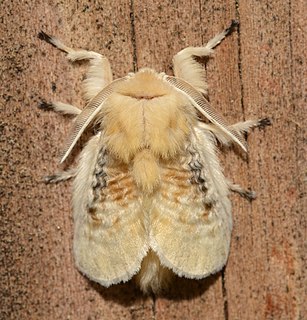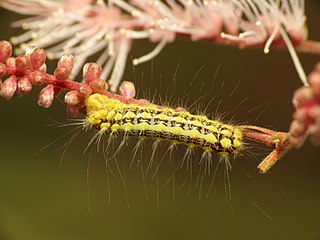
The flannel moths or crinkled flannel moths are a family of insects. They occur in North America and the New World tropics. The larvae are called puss caterpillars, and with their long hairs, resemble cotton balls. They have venomous spines that can cause a painful sting and inflammation lasting for several days. In some cases, the sting may cause headache, nausea, and shock-like symptoms. Perhaps the most notorious for stinging is the caterpillar of Megalopyge opercularis.

The Zygaenoidea comprise the superfamily of moths that includes burnet moths, forester moths, and relatives.

The Dalceridae are a small family of zygaenoid moths with some 80 known species encompassing about one dozen genera mostly found in the Neotropical region with a few reaching the far south of the Nearctic region.

Megalopyge crispata, the black-waved flannel moth, crinkled flannel moth or white flannel moth, is a moth of the Megalopygidae family. It is found along the east coast of the United States, and as far inland as Oklahoma.

Podalia marmorata is a moth of the family Megalopygidae. It is found in South America, including Peru.
Repnoa is a genus of moths in the family Megalopygidae. It contains only one species, Repnoa imparilis, which is found in French Guiana.
Vescoa is a genus of moths in the family Megalopygidae. It contains only one species, Vescoa ma, which is found in Peru.
Psychagrapha is a genus of moths in the family Megalopygidae described by Francis Walker in 1855. The genus was established in the Psychidae, but was transferred to the Megalopygidae by David Stephen Fletcher and I. W. B. Nye in 1982.
Microrape nivea is a moth of the family Megalopygidae. It was described by Walter Hopp in 1922. It is found in Bolivia.
Norape argyrorrhoea is a moth of the Megalopygidae family. It was described by Jacob Hübner in 1825. It is found in Argentina, Trinidad, Brazil, Guyana, Venezuela, Paraguay, Panama, Costa Rica and Mexico.
Norape beggoides is a moth of the Megalopygidae family. It was described by Harrison Gray Dyar Jr. in 1910. It is found in Brazil.
Norape laticosta is a moth of the Megalopygidae family. It was described by Harrison Gray Dyar Jr. in 1910. It is found in Mexico (Guerrero).

Norape tener, the mesquite stinger moth is a moth of the family Megalopygidae. It was described by Herbert Druce in 1897. It is found in south-eastern Arizona, southern New Mexico and Mexico.
Trosia ochracea is a moth of the family Megalopygidae, first described by Walter Hopp in 1922. It is found in Brazil.
Podalia contigua is a moth of the Megalopygidae family. It was described by Francis Walker in 1866.
Podalia dimidiata is a moth of the Megalopygidae family. It was described by Gottlieb August Wilhelm Herrich-Schäffer in 1856. It is found in Brazil.

Podalia orsilochus is a moth of the Megalopygidae family. It was described by Pieter Cramer in 1775. It is found in Mexico, Costa Rica, Brazil, Guyana and Venezuela.
Podalia annulipes is a moth of the family Megalopygidae. It was described by Jean Baptiste Boisduval in 1833. It is found in Brazil.
Podalia habitus is a moth of the family Megalopygidae. It was described by Henry Edwards in 1887. It occurs in Mexico.





